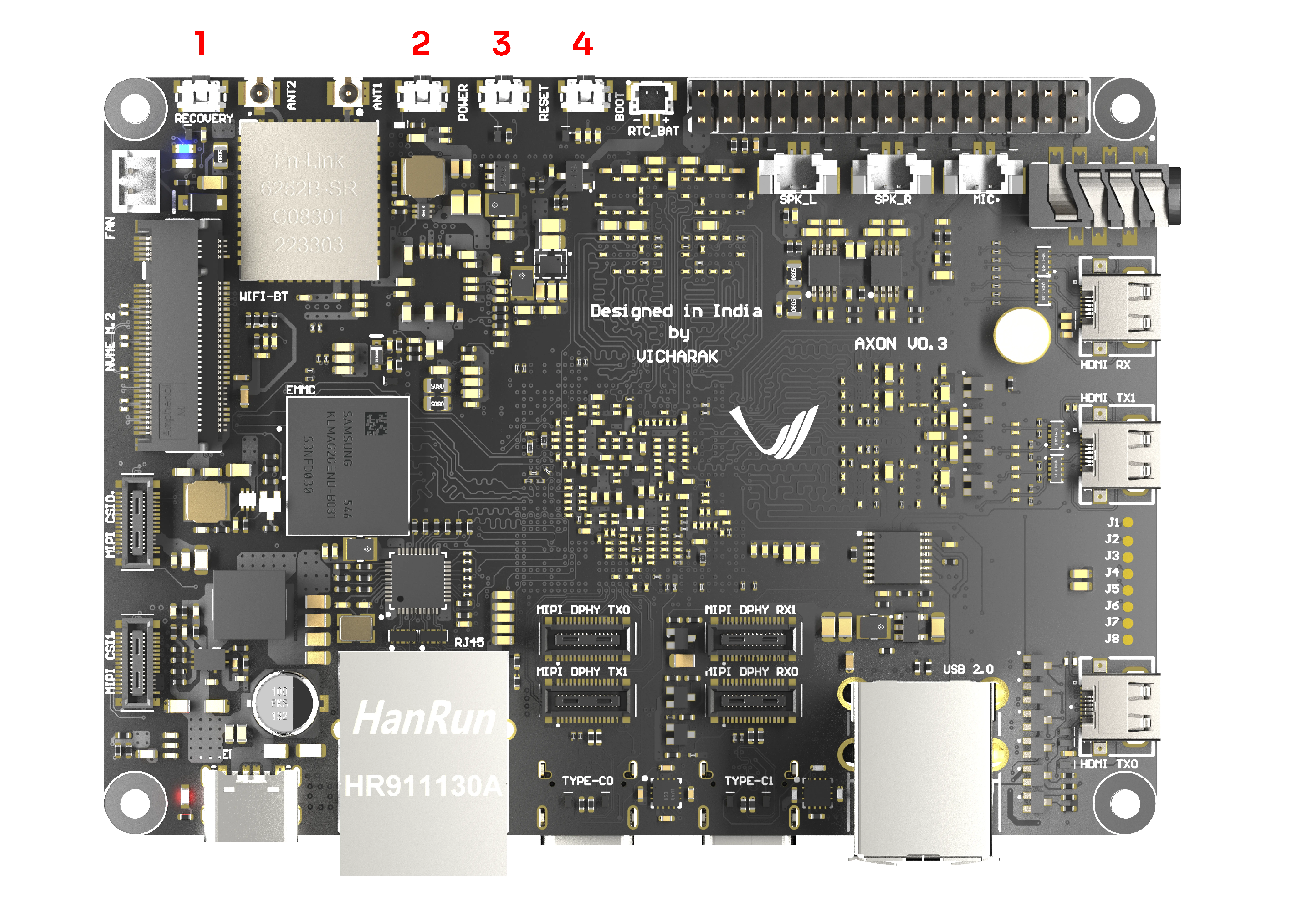Getting Started
For Axon, Vicharak has provided all the necessary accessories and information to get started with the board. This section will guide you through the initial setup process and provide you with the necessary information to get started with Axon.
What’s in the box?
- Axon
Single-board computer optimized for high-performance computing and AI.
Powered by Rockchip RK3588 SoC (octa-core CPU: quad-core Cortex-A76 and quad-core Cortex-A55).
8GB/16GB/32GB LPDDR4x RAM, 32GB eMMC storage, 30-pin GPIO header.
Pre-installed with Ubuntu 22.04 (Jammy).
- PD Cable
Supplies power to Axon.
Ensures stable and efficient power delivery via USB-C with Power Delivery technology.
- Wi-Fi and Bluetooth Antennas
Includes custom made pcb antennas for both Wi-Fi ( 2.4 & 5Ghz ) and Bluetooth connectivity.
These antennas ensure greater signal range and reliable connectivity for Wi-Fi and Bluetooth devices.
What else do you need?
1. 12V PD power adapter ( 20-60W )
2. Micro HDMI or Type-C DP cable to drive Display Monitor
3. USB2.0 Keyboard and Mouse
4. Monitor with HDMI/Type-C DP input
5. USB-C to USB-A Male cable (optional)
6. SD-card (optional)
7. Internet Connection (optional)
8. USB to TTL Serial Cable (optional)
Note
Axon OS Images
Axon OS Credentials
Note
Username : vicharak
Password : 12345
Getting Started with eMMC
Turning board on
Axon comes pre-loaded with Ubuntu (Jammy) operating system on
its eMMC (embedded MultiMediaCard) storage, and it offers support for
SD-card boot mode.
If users wish to explore different operating systems, they must utilize the appropriate firmware to program the board accordingly.
In the boot priority, SD-card takes the highest precedence, followed by
eMMC. In practical terms, if there’s a SD-card attached to Axon,
it will initiate the boot process from it. In the absence of an SD-card,
the default boot destination becomes the eMMC storage.
For the purpose of this guide, we will focus on the eMMC storage and the
pre-installed Ubuntu (Jammy), omitting detailed instructions for
SD-card boot configurations.
Connect the PD cable to the Axon board and the PD adapter to the power socket. Once the power is connected, the board will automatically turn on.
Danger
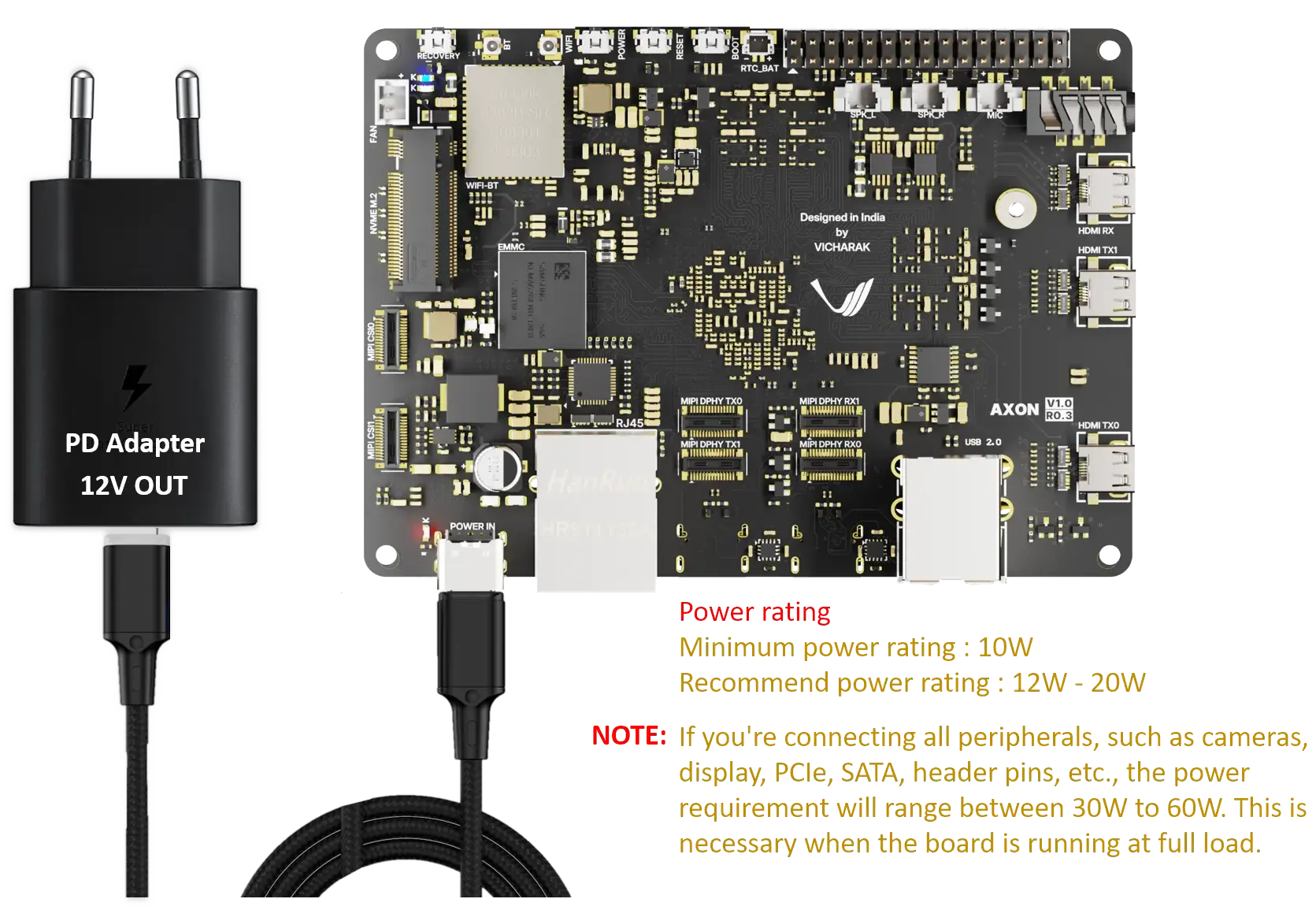
Axon is pre-installed with Ubuntu (Jammy) on its eMMC storage.
So, when you power on the board, it will boot from the eMMC storage by default.
Warning
Remove SD-card if inserted
Verify the power LED
Upon connecting the power cable, the activation of the Red LED serves as an immediate visual indicator of the board’s power status. This LED signifies that the Axon is receiving power, and its illumination provides users with a tangible confirmation of the successful power connection.
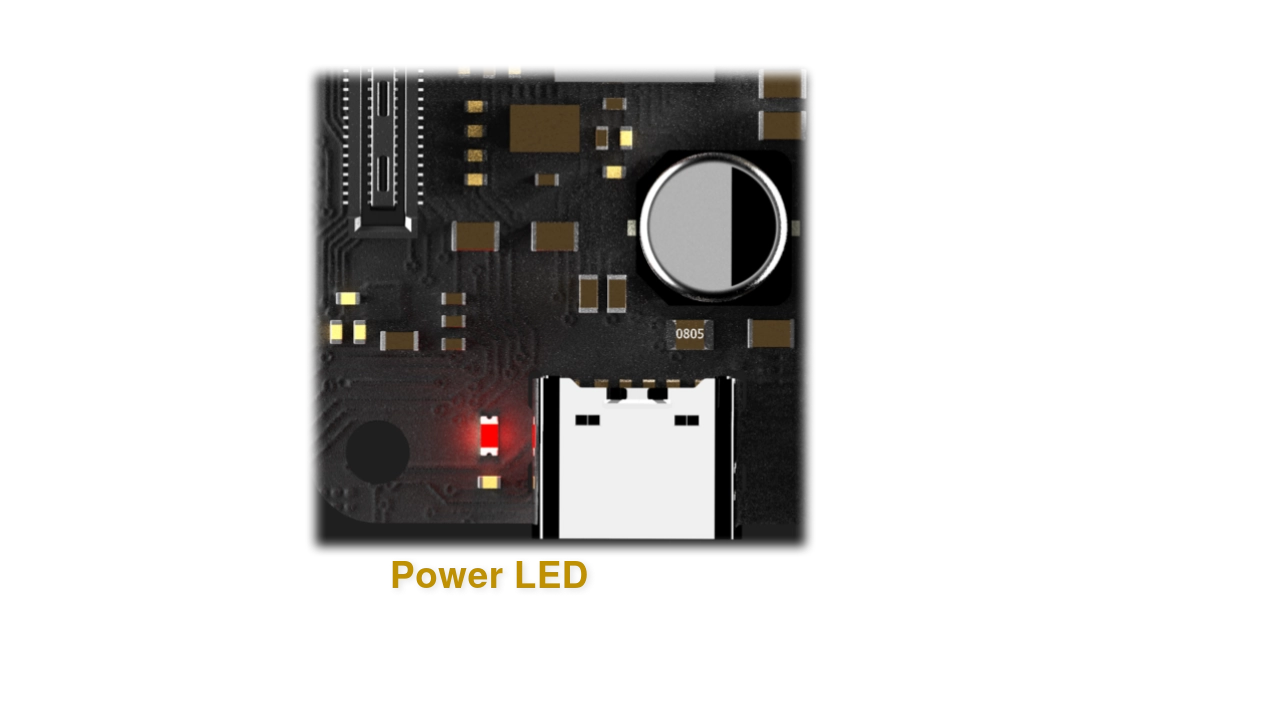
Verify the status LED
The activation of the white LED, marked by a blinking pattern, signifies the completion of the booting process. This visual cue assures users that the Axon has successfully booted from its storage medium and is ready for further configuration.
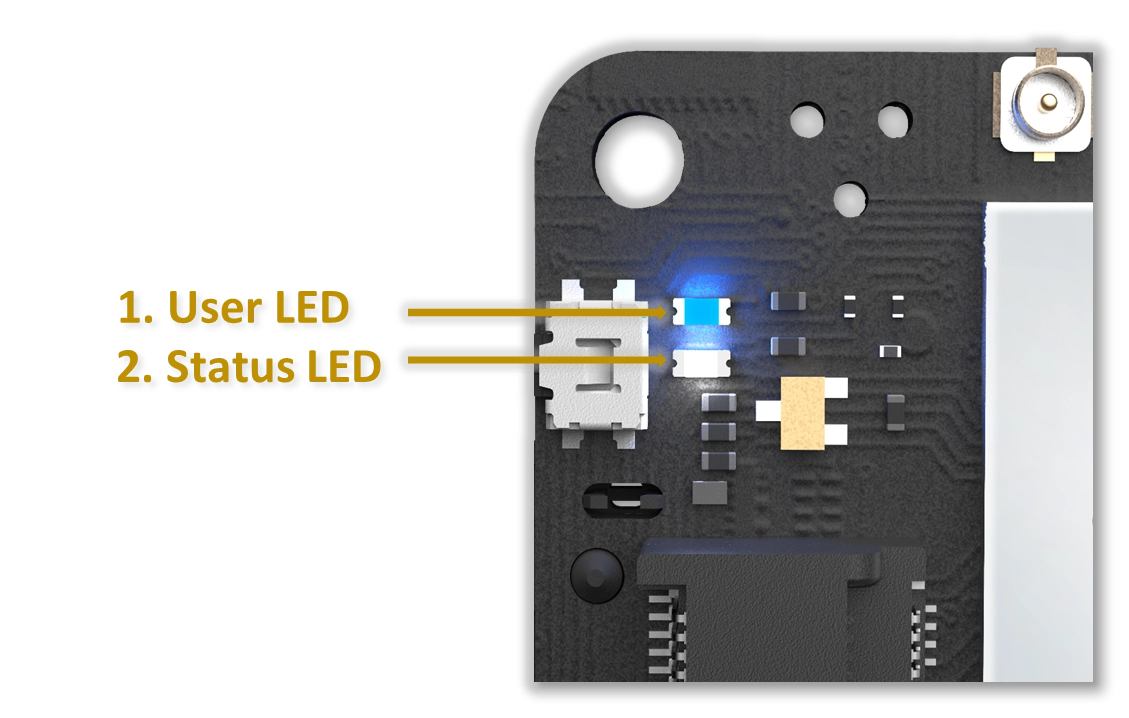
Warning
Available Boot Modes
Booting from SD card
To boot from SD card, please follow below document.
How to access your Axon board ?
There are multiple ways to access your Axon. You can connect the Axon SBC to a monitor using the micro HDMI port, or you can connect it to your computer headless using SSH or serial console.
For the initial setup process, we recommend connecting the Axon to a monitor using the micro HDMI port. Once the initial setup is complete, you can connect the Axon to your computer using the USB-C port.
Note
If you want to access the serial console, Skip to the Serial Console section.
If you want to access the Axon using SSH, Skip to the SSH section.
1. Using Micro HDMI port
Axon is equipped with two micro HDMI ports, which allows for easy connection to a display. By using a micro HDMI to HDMI cable or adapter, users can connect Axon to a monitor or TV with an HDMI input.
This enables direct visual access to the graphical user interface (GUI) or command-line interface (CLI) on the connected display.

Connect the Micro HDMI to HDMI cable to the Axon and the monitor. Once the cable is connected, the Axon will automatically detect the monitor and display the output.
Check out Linux Start Guide
Once the Axon is connected to the monitor, you can follow the Linux Start Guide to complete the initial setup.
2. Using Serial Console
Axon also provides a serial interface, typically in the form of UART (Universal Asynchronous Receiver-Transmitter) pins.
Users can access the system’s console or terminal interface by connecting to these serial pins using a serial cable or adapter. This method is often used for debugging, troubleshooting, or accessing the system when other interfaces are not available.
Preparation
To access Axon through the serial interface, you will need the following:
A computer with a serial terminal application installed (such as PuTTY or minicom).
A USB to UART serial cable or adapter (such as FTDI or PL2303).
Micro USB or USB-C cable.
Hardware Setup
Connect the USB to UART serial cable or adapter to your computer.
Connect the serial cable or adapter to Axon.
Serial FTDI Pin |
Header GPIO Pin |
Schematic Name |
|---|---|---|
GND |
Pin 6 |
GND |
TX |
Pin 4 (GPIO0_B5) |
UART2_TX_M0_DEBUG |
RX |
Pin 2 (GPIO0_B6) |
UART2_RX_M0_DEBUG |
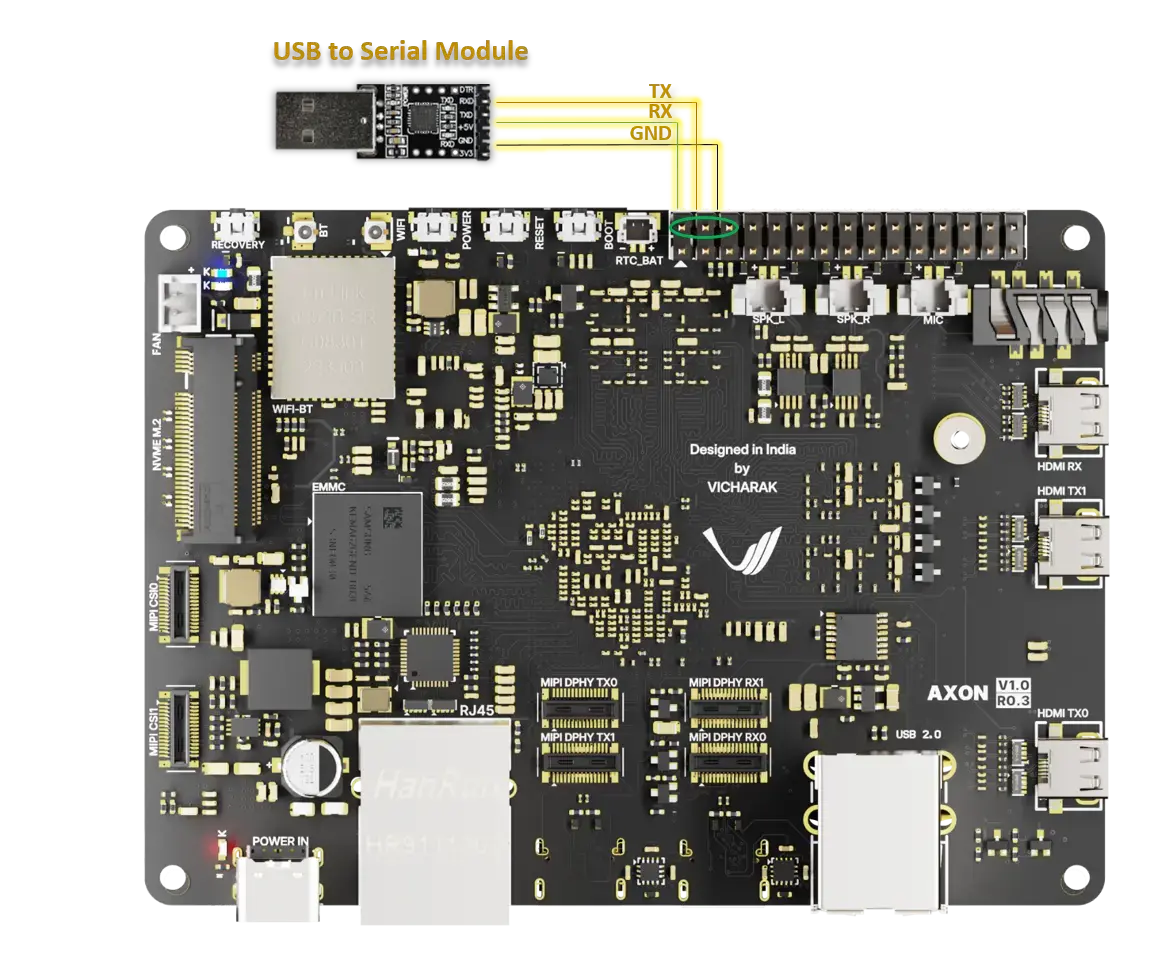
Note
When accessing Axon through the serial interface, it is important to configure the serial parameters correctly. For RK3588-based systems, the following parameters are typically used:
Warning
Running the Serial Console Program
Download and install the PuTTY program.
- Open the PuTTY program and configure the serial parameters as shown
in the image below.
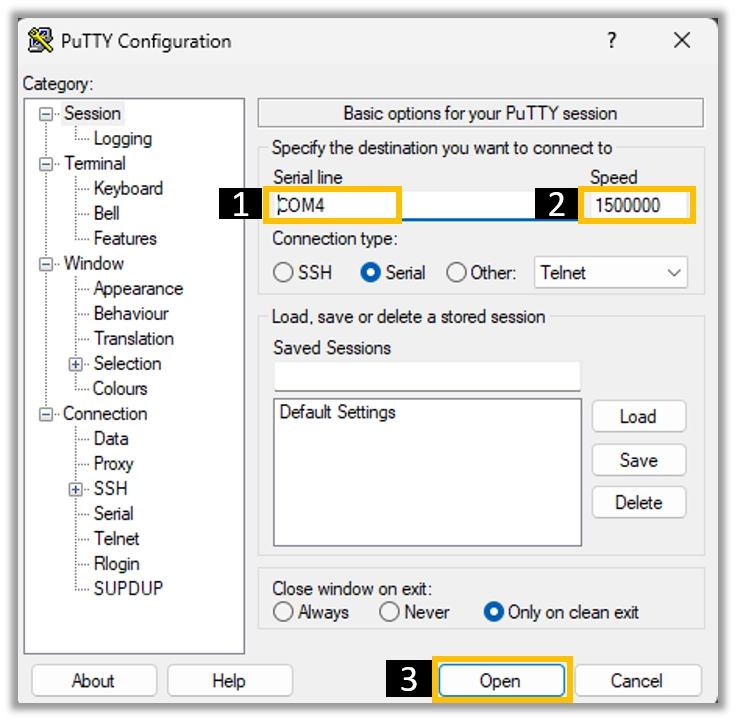
Click on the Open button to open the serial console.
You will now be able to access the serial console.
- Download and install the
TeraTerm program.
Open the TeraTerm program and configure the serial parameters.
On the Setup menu, click on Serial port.
Select the serial port number and configure the serial parameters as shown in the image below.

Click on the OK button to open the serial console.
You will now be able to access the serial console.
Install the GTK-Term program using the following command:
sudo apt-get install gtkterm
Open the GTK-Term program and configure the serial parameters.
On the File menu, click on Port.
Select the serial port number and configure the serial parameters as shown in the image below.
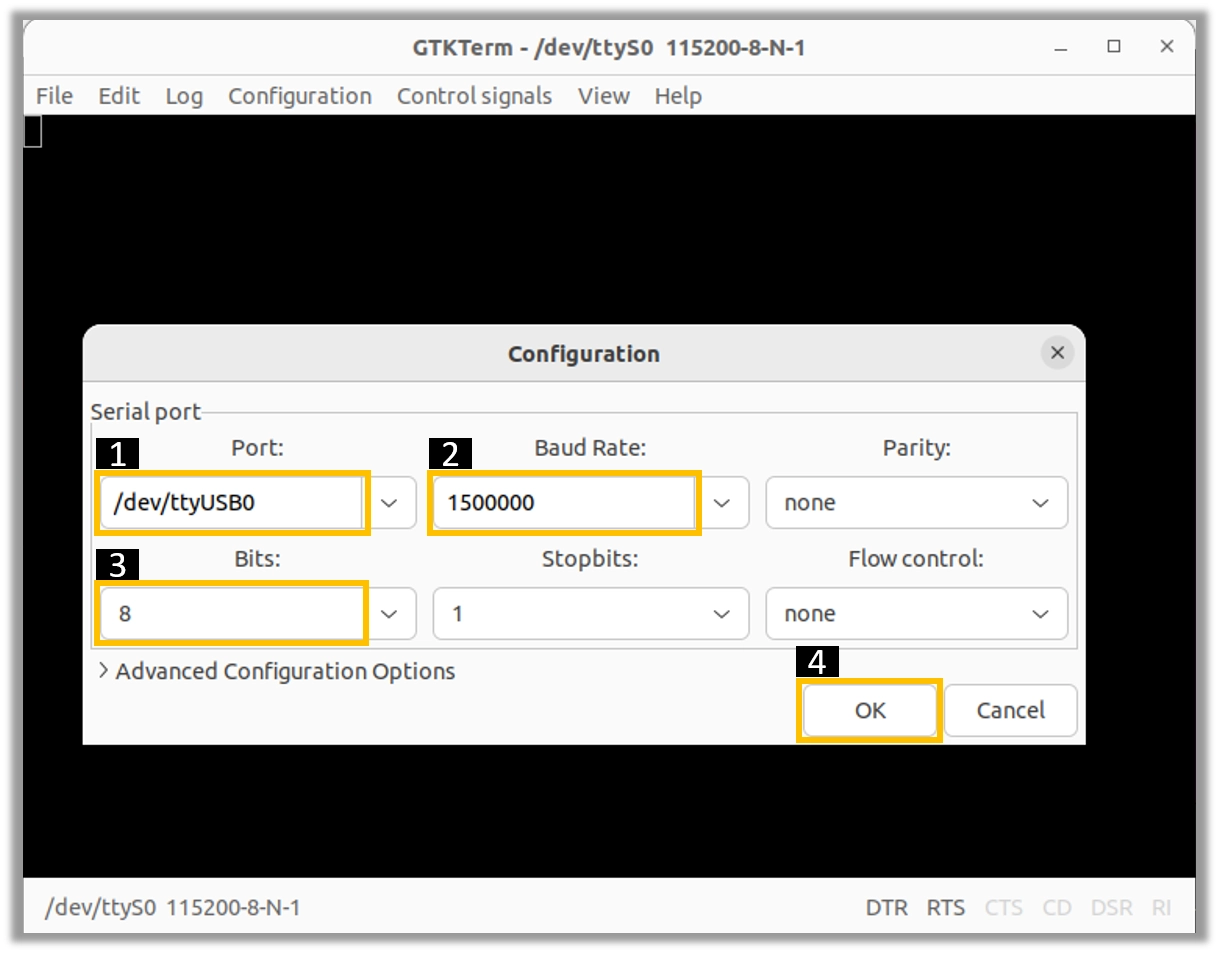
Click on the OK button to open the serial console.
You will now be able to access the serial console.
Note
Read minicom configuration from Linux Minicom guide.
3. Using SSH
Board supports SSH (Secure Shell), which allows for secure remote access to the system. By establishing an SSH connection, users can remotely connect to the board from another device, such as a computer or smartphone, over a network. This method provides a secure command-line interface to administer, configure, and execute commands on the board.
Install OpenSSH server
You can install both OpenSSH components on Windows devices using the Windows Settings.
To install the OpenSSH components, follow these steps:
Open the Settings menu and click on Apps, then select Optional Features.
Look through the list to check if OpenSSH is already installed. If it’s not, at the top of the page, click on Add a feature and then:
Find OpenSSH Client and click on Install.
Find OpenSSH Server and click on Install.
After the installation process is complete, go back to Apps and Optional Features to verify that OpenSSH is listed.
Open the Services desktop app.
Click on Start, type services.msc in the search box and then click on the Service app or press ENTER.
In the details pane, double-click on OpenSSH SSH Server.
On the General tab, choose Automatic from the Startup type drop-down menu.
To start the service, click on Start.
Verify OpenSSH server
Once installed, you can connect to OpenSSH Server from a Windows device with the OpenSSH client installed.
From a PowerShell prompt, run the following command.
ssh username@ip_address
Example:
ssh vicharak@192.168.29.69
Tip
To find your IP address on Windows, use the following command:
ipconfig
For Linux users, use the following command:
ip a
Accessing Board through SSH
To access the board through SSH, you can use either of the following commands:
SSH using the IP address
ssh username@ip_address
Tip
Replace “username” with the appropriate username for the board and “ip_address” with the actual IP address assigned to the board on the network.
SSH using the PC name (hostname)
ssh username@pc-name.local
Tip
Replace “username” with the appropriate username for the board and “pc-name” with the actual PC name assigned to the board on the network.
For Linux users, you can find your username using whoami command and,
hostname using cat /etc/hostname
4. Set up automatic Wi-Fi connection on boot
In the following example, we will set up automatic Wi-Fi connection on boot for the wlan0 interface. This will be useful if you are using a headless system. That means you will not need to connect a monitor, keyboard, or mouse to your system to connect to WiFi.
1. Edit the ** ``/usr/lib/vicharak-config/conf.d/before.txt`` ** file and add the following lines:
connect-wi-fi <network name> <password>
Example:
connect-wi-fi vicharak_5g vcaa_g123
2. Reboot the system.
Axon Boot modes
Boot Mode |
Description |
|---|---|
Normal Mode |
Normal boot mode is the default boot mode. In this mode, the board boots from the eMMC or SD-card. Each partition loads in order and enters the system normally. |
Loader Mode |
Loader mode is used to upgrade the bootloader. In this mode, the bootloader will wait for the host command for firmware upgrade. On success, the board boots from the eMMC or SD-card, and the board enters the system normally. |
Maskrom Mode |
Maskrom mode is used to repair the board. In a situation where the
bootloader is damaged, the board can enter the maskrom mode.
In general, there is no need to enter Maskrom mode.
In this mode, the bootrom code waits for the host to transmit the
bootloader code through the USB-C port, load and run it.
|
See also
